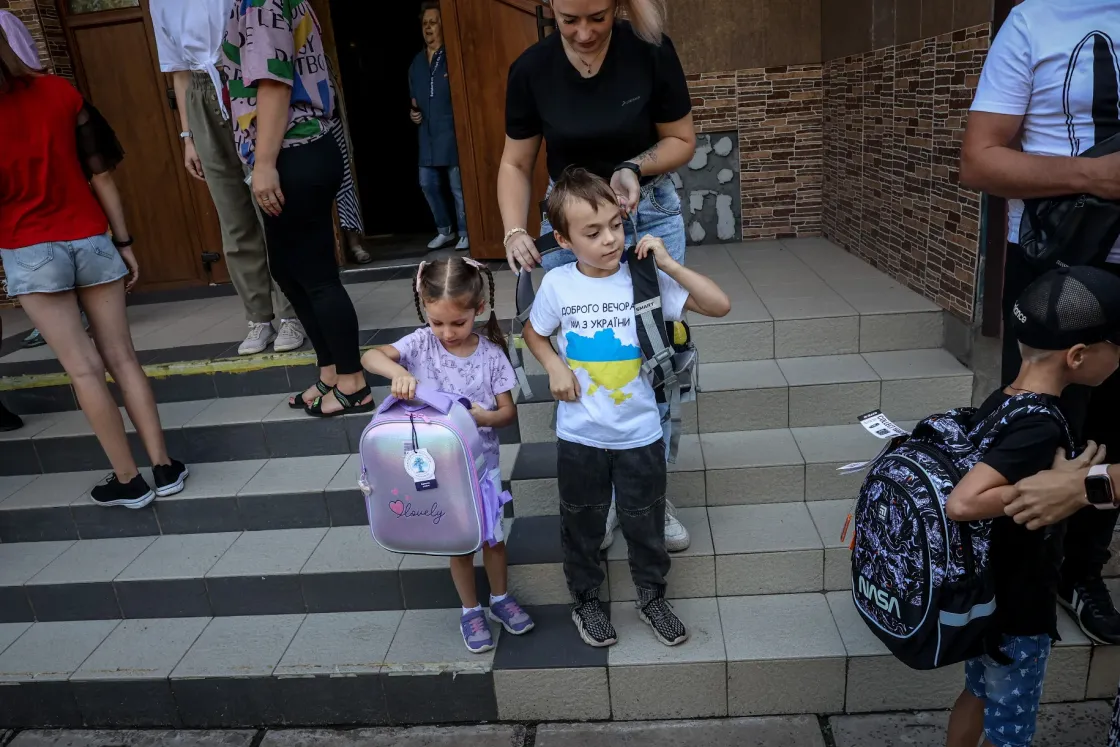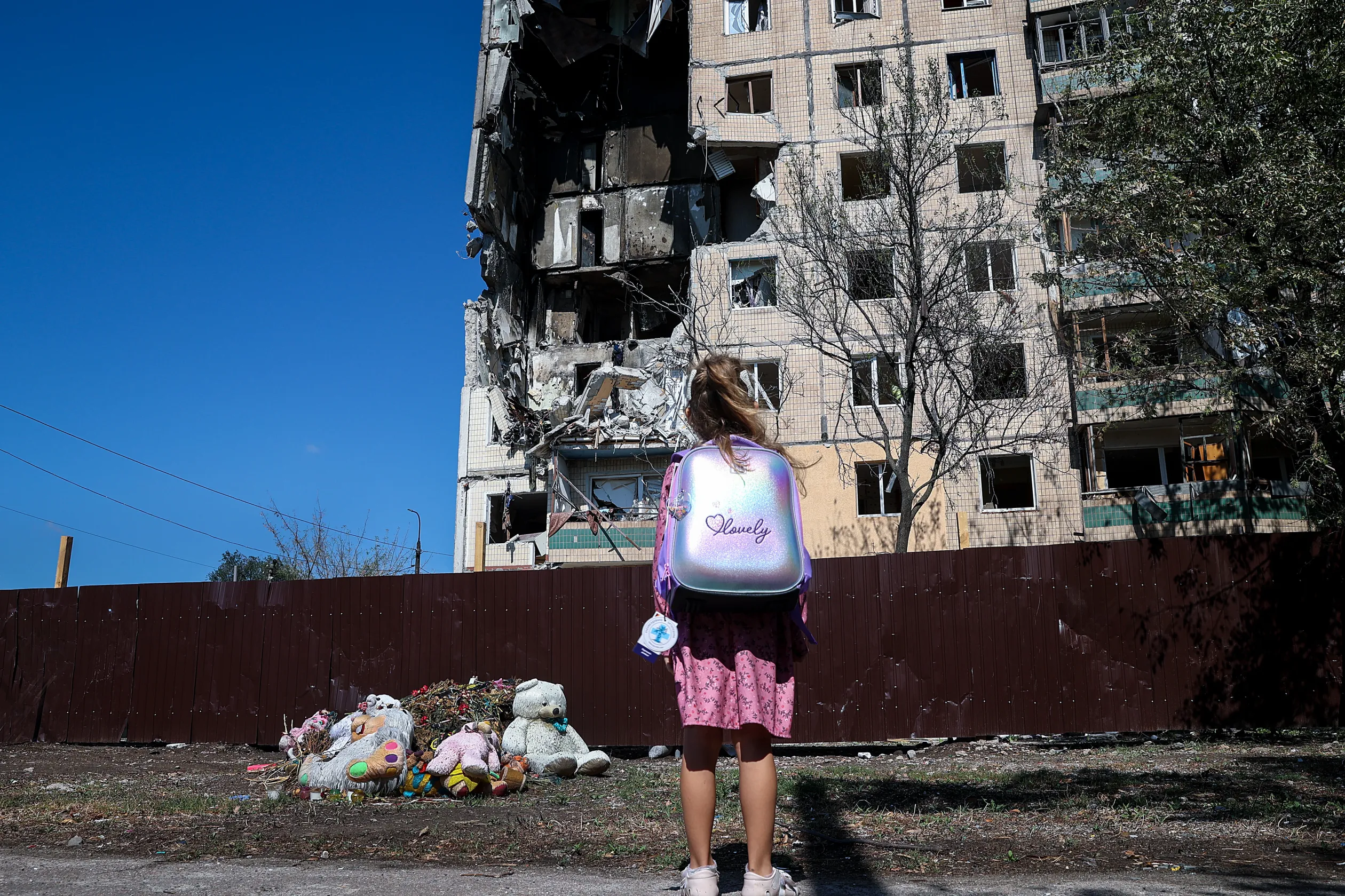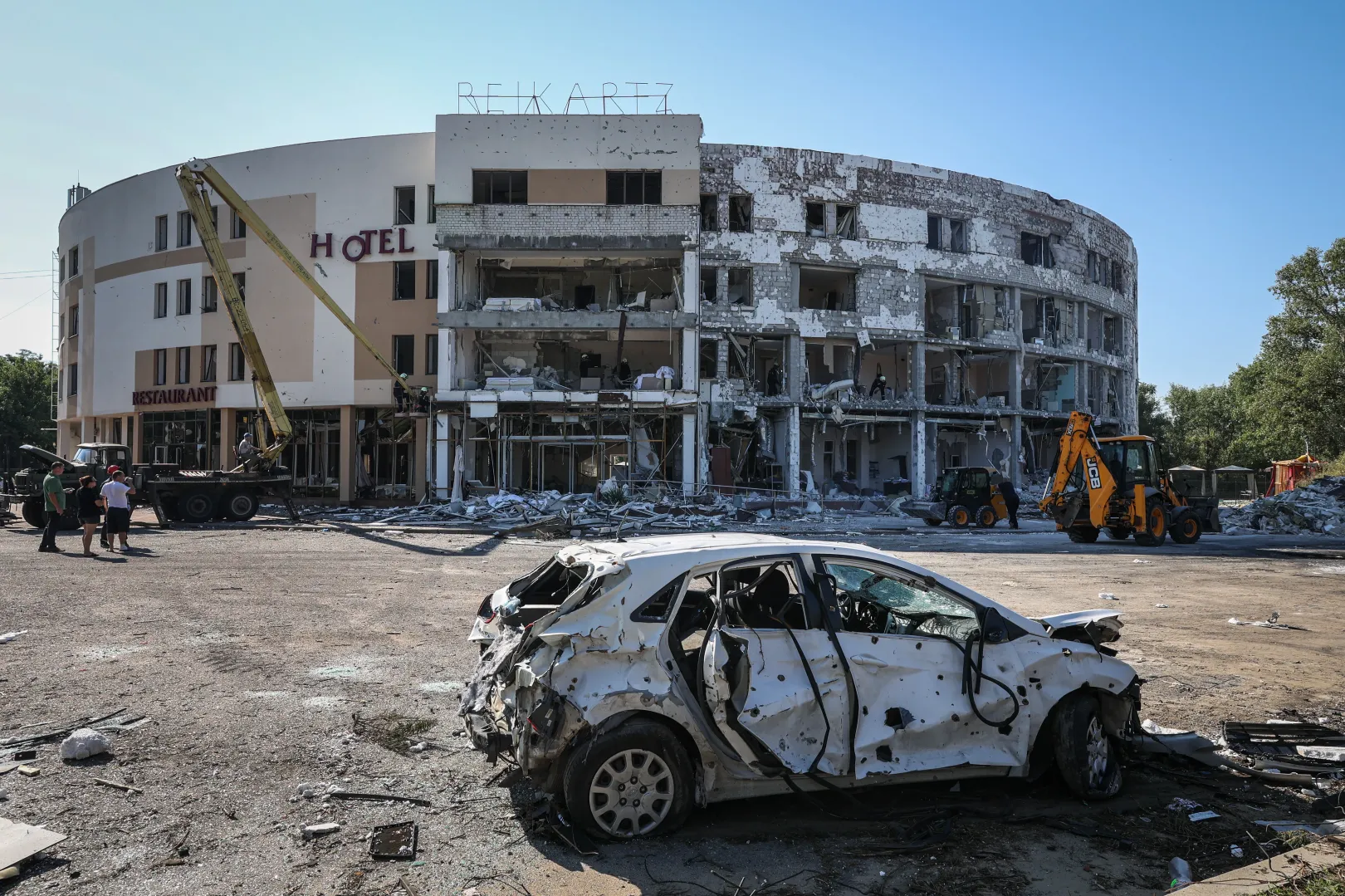We heard the impact of a missile, so I wanted to turn back, but they're handing out school bags

Although the war in Ukraine has been going on for a year and a half, children are getting ready for the new school year. In most parts of the country, however, education will still be online only. Some schools are even putting together courses on mine safety for the new school year. Although Russian forces have not achieved their original objective, the end of the war still isn't in sight. Russian missile attacks are continuous, even in places further away from the frontlines, but there are even more of them in towns closer to the fighting, destroying countless civilian targets. This is our report from Ukraine.
"On the way here, we heard another missile hit, and I wanted to turn back, but they're handing out school bags. Makar is going to be a first grader, and I want him to at least have a sense of what it’s like to go to school" – Of course, Makar won't actually be going to school, because the school building has no windows, and what windows there are have been boarded up. The little boy is still happy to have a school bag on his shoulders. He prefers to hide behind his mother while we talk. This way, he can't see either me or the ten-storey apartment building opposite, one side of which had eight floors wiped out by a Russian missile attack at the end of July. Six people were killed, including a woman and her ten-year-old daughter, who is now being commemorated with the stuffed animals in front of the house on the avenue in Kryvyi Rih. With the arrival of refugees from other parts of the country, the city’s population has ballooned to 700,000.
It won't be a heavy bag
Makar will learn to read and write online, with his mother's help. He hasn't seen his father, who’s at the front, for six months. "The soldiers themselves don't know when the war will end, and I certainly have no idea," Irina says. Her brother is also fighting against the Russian invaders somewhere in eastern Ukraine.
A bit further away, a seventh-grader girl is daydreaming about how nice it would be if she actually had to go to school on September 1. "Who would have thought that she would one day long for this," her mother, who brought all three of her children to get school bags, says with wry humor. While she’s happy, she adds that a tablet would be better, now that her youngest will also be in school, because there's no point in packing a school bag. The older ones have plenty of experience with online education, as it's been three years since Ukraine has had full-time, in-person education: at first, schools had to close because of Covid-19, just like in many other parts of the world, and then Russia started its war.
One thing's for certain: this academic year will also be a year of war in Ukraine: tens of thousands of teachers will be sitting in front of their computer screens as internally displaced persons, or working from home, but close to a shelter, while some will work from abroad. Whether there's a shelter near a school is also a key issue.
Where an adequate shelter is available, classes will be held as usual, at least in the slightly safer, western half of the country. Schools which have no shelter nearby will not be allowed to hold in-person classes.
In the east, for example in Kryvyi Rih or Zaporizhzhya, even if there is a shelter close by, there will only be blended learning, i.e. lessons will be mostly online, with children only allowed to go to school once or twice a week at most so that they can see each other. But there are cities where this is not even an option, such as Kherson, which is constantly under fire from Russian forces across the Dnipro river.
Many flee straight to Kryvyi Rih
Kherson, which was once home to 300,000 people, still had a population of 100,000 at the end of the nine-month Russian occupation in November. It now has a population between 50,000 and 70,000. About 40,000 went to Kryvyi Rih, some left in time, before the Russian occupation began, others only afterwards, as Kherson was cut off from the rest of Ukraine during most of its occupation.

According to the deputy mayor of Kryvyi Rih, only 20,000 people left the town of 630,000 before the war, but a total of 80,000 refugees have arrived. "Each refugee, including children, receives 2,500 hryvnias (about 25,000 forints) a month from the city's budget," Sergey Milyutin said. Those living in shelters are also provided with free meals and medical care. "This welfare programme is attractive, so many people come to us." Milyutin doesn't mind: the iron ore-producing industrial town, which accounted for a tenth of Ukraine's GDP during peacetime, was designed for a million people in the 1960s and 1970s, during the Soviet era, so there are enough vacant apartments.
"You can buy a one-bedroom apartment for two thousand dollars, not in very good condition, of course, but there are three-bedroom apartments for sale for 15 thousand dollars," the deputy mayor told us. Many people in Kryvyi Rih own three or four apartments. "It is not easy to rent them out, and the utility costs have increased, so the city has offered to cover these costs for the owners if they make the apartments available to refugees."
Mine safety for children
There are many children among the refugees – and it's not just the locals who are waiting for school bags. For them, however, if they continue to be enrolled in the school in their town of origin, the only option is online education. Many parents, however, would prefer to transfer their children to a local school which has a shelter, so that they can see the inside of the school at least once or twice a week. This, however, presents a problem for the schools in the towns they came from, as their faculty can only teach online. "Salaries depend on the number of students a teacher teaches. So we prefer to ask children to stay in their old schools, because teachers can teach online from anywhere and keep their salaries," Milyutin explained, pointing out the social aspect of the situation.
Whether online or offline, a new subject is sure to appear, at least in the schools of Kryvyi Rih: mine safety. In the year and a half since Russia launched its war against Ukraine on 24 February last year, vast areas of Ukraine have been mined by the invading Russian forces:
It's not only the front line between the two sides that is mined, but also the areas that the Russian army had quickly captured in the early days but lost by the end of 2022.
These include the eastern part of Kharkiv region, the city of Kherson and the area around Kryvyi Rih, where the Russian forces came within 200 meters of the city at the beginning of the war. During their retreat, they mined large territories in these places, including, at times, playgrounds, according to the deputy mayor.
"There's a desperate need for this knowledge about mine awareness, so that they know what to look out for and what not to touch." And it's not just landmines, but also the 8-centimeter butterflies of cluster bombs.
Rockets killing busker girls
There is a higher chance of schools being opened in cities further away from the front, although the west and south-west of the country are not entirely immune to Russian missiles either: since the last third of July, Russian forces have been intensively attacking Odessa, and in mid-August, the Lviv region suffered its worst missile attack since the start of the war.


But towns closer to the front are suffering more attacks: Dnipro was hit last Monday night, Kramatorsk on Monday and Tuesday, and more recently Kryvyi Rih, and Zaporizhzhya on the Dnipro river, 130 kilometres to the east, where a resdiential building was hit by rockets at the end of July, and then on 9 August. The most recent attack was near a playground where a 19- and a 21-year-old girl were playing music in the street, raising money for the Ukrainian army. They were taking a break when the two cruise missiles, which can be launched from a distance of 300 kilometres, hit. Svetlana Semeykina died on the spot and Krystyna Spicina died in hospital.
This was their last concert, barely an hour before they died:
Hotels have also become a regular target
The two girls were buried last week in Zaporizhzhya, where a day before their funeral, a rocket also hit the Reikartz hotel, killing three people and injuring nine. Since the beginning of the war, the hotel has been hosting representatives of the United Nations and usually foreign journalists. In the Russian news reports, it was presented as a place which housed mercenaries.

Three days earlier, a hotel in Pokrovsk had also been hit by a rocket. This too was mostly occupied by journalists. Seven people were killed in the attack.
The café in Kramatorsk, which was hit by an Iskander missile on 27 June, was also known as a popular meeting place for foreign journalists. Thirteen people were killed, including three underage girls: a 17-year-old who was about to graduate from high school and a pair of 14-year-old twins. Among the dead was a foreigner, the American Frank Tortorici, who was fighting as a foreign legionnaire with the Ukrainian forces.
Telex correspondents were on the ground in Kramatorsk last Monday and Tuesday night and heard several explosions. Monday's attack didn't hit a residential building, but the site of a former bakery, injuring three people.